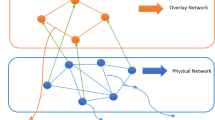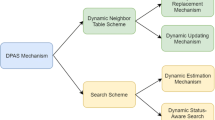Abstract
Replication is a widely used technique in unstructured overlays to improve content availability or system performance. A fundamental question often addressed by previous work focused on: how many replicas ought to be allocated for each data item given the fixed query rates and limited storage capability? In this paper, we have put forth two optimal replica distributions to achieve the highest success rate and the lowest message consumption. Especially, we have investigated the influence of item size on replica distribution. Our results show that Square-Root Replication, which is traditionally considered to be optimal, is not always the best choice. Our study offers a new deep understanding of resource managment in self-organized unstructured overlays.
Similar content being viewed by others
References
Cohen E, Shenker S. Replication strategies in unstructured peer-to-peer networks. In: Proceedings of ACM SIGCOMM’ 02. New York: ACM, 2002. 177–190
Leontiadis E, Dimakopoulos V V, Pitoura E. Creating and maintaining replicas in unstructured peer-to-peer systems. In: Proceedings of Euro-Par’06. Berlin: Springer-Verlag, 2006. 1015–1025
Saito Y, Shapiro M. Optimistic replication. ACM Comput Surv, 2005, 37: 42–81
Thampi S M, Sekaran K C. Survey of search and replication schemes in unstructured P2P networks. Network Protocols Algorithms, 2010, 2: 93–131
Lv Q, Cao P, Cohen E, et al. Search and replication in unstructured peer-to-peer networks. In: Proceedings of ICS’02. New York: ACM, 2002. 84–95
Goel S, Buyya R. Data replication strategies in wide area distributed systems. In: Qiu R, ed. Enterprise Service Computing: From Concept to Deployment. Hershey, Pennsylvania: Idea Group Inc, 2006. 211–241
Feng G F, Jiang Y Q, Chen G H, et al. Replication strategy in unstructured peer-to-peer systems. In: Proceedings of IPDPS’07. Washington DC: IEEE Computer Society, 2007. 1–8
Baev I D, Rajaraman R. Approximation algorithms for data placement in arbitrary networks. In: Proceedings of SODA’01. New York: ACM, 2001. 661–670
Chekuri C, Kumar A. Maximum coverage problem with group budget constraints and applications. In: Proceedings of APPROX’04. Berlin: Springer, 2004. 72–83
Shmoys D B, Swamy C, Levi R. Facility location with service installation costs. In: Proceedings of SODA’04. New York: ACM, 2004. 1088–1097
Sozio M, Neumann T, Weikum G. Near-optimal dynamic replication in unstructured peer-to-peer networks. In: Proceedings of SIGMOD/PODS’08. New York: ACM, 2008. 281–290
Venugopal S, Buyya R, Ramamohanarao K. A taxonomy of data grids for distributed data sharing, management and processing. ACM Comput Surv, 2006, 38: 1–53
Gkantsidis C, Mihail M, Saberi A. Random walks in peer-to-peer networks: Algorithms and evaluation. Perform Evaluat, 2006, 63: 241–263
Waxman B M. Routing of multipoint connections. IEEE J Select Areas Commun, 1988, 6: 1617–1622
Author information
Authors and Affiliations
Corresponding author
Rights and permissions
About this article
Cite this article
Feng, G., Li, W., Lu, S. et al. The optimization of replica distribution in the unstructured overlays. Sci. China Inf. Sci. 55, 714–722 (2012). https://doi.org/10.1007/s11432-011-4447-9
Received:
Accepted:
Published:
Issue Date:
DOI: https://doi.org/10.1007/s11432-011-4447-9




